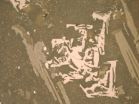(Press-News.org) The article "Collapse of superconductivity in a hybrid tin–grapheme Josephson junction array'" (authors: Zheng Han, Adrien Allain, Hadi Arjmandi-Tash,Konstantin Tikhonov, Mikhail Feigelman, Benjamin Sacépé,Vincent Bouchiat, published in Nature Physics on March 30, 2014, DOI:10.1038/NPHYS2929) presents the results of the first experimental study of the graphene-based quantum phase transition of the "superconductor-to-metal" type, i.e. transformation of the system's ground state from superconducting to metallic, upon changing the electron concentration in graphene sheet.
The system is a regular array of tin nanodisks (the radius of each disk is 200 nm) situated on a graphene substrate. Tin becomes a superconductor at temperatures lower than T0 = 3.5 degrees Kelvin. Tin nanodiscs electrically contact with each other due to electronic conductivity through graphene. At temperatures significantly below T0 the state of the nanodisk can be characterized by a single variable - "phase," defined in the period from 0 to 2π. Due to the transfer of Cooper pairs of electrons between nanodiscs the so-called Josephson junctions are formed, which seek to establish a coherent superconducting state with uniform nanodisk phases across the entire lattice.
Graphene allows to gradually change the density of conduction electrons in it by changing the voltage on the electrostatic gate, and thus the strength of Josephson junctions between tin nanodiscs. Phase correlations among nanodiscs are destroyed by thermal fluctuations at temperatures above the critical temperature Tc. At high density of conduction electrons in graphene the measured value Tc (around 0.5-0.7 K) is in good agreement with the previously developed theory, published in the article by Feigel'man, M.; Skvortsov, M. & Tikhonov, K. Theory of proximity-induced superconductivity in graphene, Solid State Communications, *149*, 1101 - 1105 (2009).
Upon lowering the electron density of grapheme the energies of Josephson junctions weaken due to increase in the resistance of graphene, and the temperature of transition into coherent state drops sharply to below the minimum temperature of the experiment (60 mK). In other words, the spatial phase coherence between different individual nanodisks is destroyed solely by quantum (independent of temperature) phase fluctuations. As a result, superconductor-to-metal quantum phase transition takes place.
First approach to the theory of such a phase transition have previously been developed in the paper Feigel'man, M.; Larkin A. & Skvortsov, M. "Quantum superconductor-metal transition in a proximity array," Physical Review Letters *86* 1869, (2001).
In the domain of lowest measurable temperatures the resistance of the studied array turns out to be nearly temperature-independent, and, at the same time, it is an exponentially sharp function of voltage on the electric back-gate; this observation is yet to be explained as no complete theory is capable of describing it at present.
In addition to the above-mentioned superconductor-to-metal transition, the authors discovered the so-called "superconducting glass" state, which is created as a result of disorder and frustration in the Josephson junctions, but nevertheless corresponds to some of the minima of the total energy of the Josephson junctions array. Here, the controlling parameter is the strength of external magnetic field. Competition of periodic dependency on the magnitude of magnetic flux through the elementary cell of the nanodisk lattice and random dependency on the same parameter (due to mesoscopic fluctuations) leads to a phase diagram of the "re-entrant" type. Namely, the magnitude of the maximum superconducting current that flows through the entire lattice depends non-monotonically upon an external magnetic field; first it decreases (all the way down to zero), and then reappears with the increase of the magnetic field in a certain range of its values.
INFORMATION: END
Scientists observe quantum superconductor-metal transition and superconducting glass
A team including MIPT physicist observed quantum superconductor-metal transition and superconducting glass
2014-04-16
ELSE PRESS RELEASES FROM THIS DATE:
Stanford scientists develop 'playbook' for reverse engineering tissue
2014-04-16
STANFORD, Calif. — Consider the marvel of the embryo. It begins as a glob of identical cells that change shape and function as they multiply to become the cells of our lungs, muscles, nerves and all the other specialized tissues of the body.
Now, in a feat of reverse tissue engineering, Stanford University researchers have begun to unravel the complex genetic coding that allows embryonic cells to proliferate and transform into all of the specialized cells that perform myriad biological tasks.
A team of interdisciplinary researchers took lung cells from the embryos of ...
Red moon at night; stargazer's delight
2014-04-16
Monday night's lunar eclipse proved just as delightful as expected to those able to view it. On the East Coast, cloudy skies may have gotten in the way, but at the National Science Foundation's National Optical Astronomy Observatory (NOAO) near Tucson, Ariz., the skies offered impressive viewing, as seen from the pictures provided here.
Nicknamed a "blood moon," this lunar eclipse's color was similar to the majority of lunar eclipses. This has to do with the Earth's atmosphere's propensity for longer-wavelength light (e.g., the reds, oranges and yellows seen in sunrises ...
Information storage for the next generation of plastic computers
2014-04-16
Inexpensive computers, cell phones and other systems that substitute flexible plastic for silicon chips may be one step closer to reality, thanks to research published on April 16 in the journal Nature Communications.
The paper describes a new proposal by University of Iowa researchers and their colleagues at New York University for overcoming a major obstacle to the development of such plastic devices—the large amount of energy required to read stored information.
Although it is relatively cheap and easy to encode information in light for fiber optic transmission, ...
Two new species of yellow-shouldered bats endemic to the Neotropics
2014-04-16
Lying forgotten in museum collections two new species of yellow-shouldered bats have been unearthed by scientists at the American Museum of New York and The Field Museum of Natural History and described in the open access journal ZooKeys. These two new additions to the genus Sturnira are part of a recent discovery of three bats hidden away in collections around the world, the third one still waiting to be officially announced.
Up until recently the genus Sturnira was believed to contain only 14 species. In the last years closer morphological and molecular analysis have ...
Researchers: Obesity can amplify bone and muscle loss
2014-04-16
TALLAHASSEE, Fla. – Florida State University researchers have identified a new syndrome called "osteosarcopenic obesity" that links the deterioration of bone density and muscle mass with obesity.
"It used to be the thinking that the heavier you were the better your bones would be because the bones were supporting more weight," said Jasminka Ilich-Ernst, the Hazel Stiebeling Professor of Nutrition at Florida State. "But, that's only true to a certain extent."
The syndrome, outlined in the May issue of Ageing Research Reviews, explains how many obese individuals experience ...
Researchers develop a new drug to combat the measles
2014-04-16
A novel antiviral drug may protect people infected with the measles from getting sick and prevent them from spreading the virus to others, an international team of researchers says.
Scientists from the Institute for Biomedical Sciences at Georgia State University, the Emory Institute for Drug Development and the Paul-Ehrlich Institute in Germany developed the drug and tested it in animals infected with a virus closely related to one that causes the measles. As reported in the current issue of the journal Science Translational Medicine, virus levels were significantly ...
Celldex's Phase 1 study of CDX-1401 published in Science Translational Medicine
2014-04-16
HAMPTON, NJ (April 16, 2014): Celldex Therapeutics, Inc. (NASDAQ: CLDX) announced today that final data from its Phase 1 study of CDX-1401 in solid tumors, including long-term patient follow-up, have been published in Science Translational Medicine (Vol 6 Issue 232). The data demonstrate robust antibody and T cell responses and evidence of clinical benefit in patients with very advanced cancers and suggest that CDX-1401 may predispose patients to better outcomes on subsequent therapy with checkpoint inhibitors. CDX-1401 is an off-the-shelf vaccine consisting of a fully ...
Meteorites yield clues to red planet's early atmosphere
2014-04-16
Geologists who analyzed 40 meteorites that fell to Earth from Mars unlocked secrets of the Martian atmosphere hidden in the chemical signatures of these ancient rocks. Their study, published April 17 in the journal Nature, shows that the atmospheres of Mars and Earth diverged in important ways very early in the 4.6 billion year evolution of our solar system.
The results will help guide researchers' next steps in understanding whether life exists, or has ever existed, on Mars and how water—now absent from the Martian surface—flowed there in the past.
Heather Franz, ...
Mutant protein in muscle linked to neuromuscular disorder
2014-04-16
Sometimes known as Kennedy's disease, spinal and bulbar muscular atrophy (SBMA) is a rare inherited neuromuscular disorder characterized by slowly progressive muscle weakness and atrophy. Researchers have long considered it to be essentially an affliction of primary motor neurons – the cells in the spinal cord and brainstem that control muscle movement.
But in a new study published in the April 16, 2014 online issue of Neuron, a team of scientists at the University of California, San Diego School of Medicine say novel mouse studies indicate that mutant protein levels ...
Study provides crucial new information about how the ice ages came about
2014-04-16
An international team of scientists has discovered new relationships between deep-sea temperature and ice-volume changes to provide crucial new information about how the ice ages came about.
Researchers from the University of Southampton, the National Oceanography Centre and the Australian National University developed a new method for determining sea-level and deep-sea temperature variability over the past 5.3 million years. It provides new insight into the climatic relationships that caused the development of major ice-age cycles during the past two million years.
The ...
LAST 30 PRESS RELEASES:
Making lighter work of calculating fluid and heat flow
Normalizing blood sugar can halve heart attack risk
Lowering blood sugar cuts heart attack risk in people with prediabetes
Study links genetic variants to risk of blinding eye disease in premature infants
Non-opioid ‘pain sponge’ therapy halts cartilage degeneration and relieves chronic pain
AI can pick up cultural values by mimicking how kids learn
China’s ecological redlines offer fast track to 30 x 30 global conservation goal
Invisible indoor threats: emerging household contaminants and their growing risks to human health
Adding antibody treatment to chemo boosts outcomes for children with rare cancer
Germline pathogenic variants among women without a history of breast cancer
Tanning beds triple melanoma risk, potentially causing broad DNA damage
Unique bond identified as key to viral infection speed
Indoor tanning makes youthful skin much older on a genetic level
Mouse model sheds new light on the causes and potential solutions to human GI problems linked to muscular dystrophy
The Journal of Nuclear Medicine ahead-of-print tip sheet: December 12, 2025
Smarter tools for peering into the microscopic world
Applications open for funding to conduct research in the Kinsey Institute archives
Global measure underestimates the severity of food insecurity
Child survivors of critical illness are missing out on timely follow up care
Risk-based vs annual breast cancer screening / the WISDOM randomized clinical trial
University of Toronto launches Electric Vehicle Innovation Ontario to accelerate advanced EV technologies and build Canada’s innovation advantage
Early relapse predicts poor outcomes in aggressive blood cancer
American College of Lifestyle Medicine applauds two CMS models aligned with lifestyle medicine practice and reimbursement
Clinical trial finds cannabis use not a barrier to quitting nicotine vaping
Supplemental nutrition assistance program policies and food insecurity
Switching immune cells to “night mode” could limit damage after a heart attack, study suggests
URI-based Global RIghts Project report spotlights continued troubling trends in worldwide inhumane treatment
Neutrophils are less aggressive at night, explaining why nighttime heart attacks cause less damage than daytime events
Menopausal hormone therapy may not pose breast cancer risk for women with BRCA mutations
Mobile health tool may improve quality of life for adolescent and young adult breast cancer survivors
[Press-News.org] Scientists observe quantum superconductor-metal transition and superconducting glassA team including MIPT physicist observed quantum superconductor-metal transition and superconducting glass




